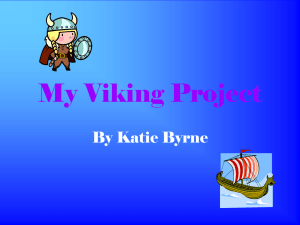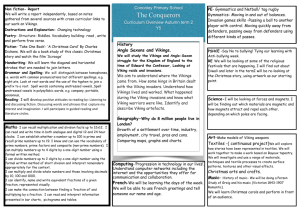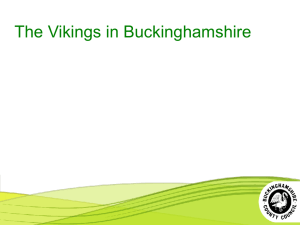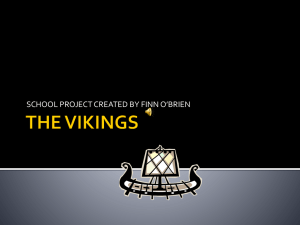Further resources
advertisement
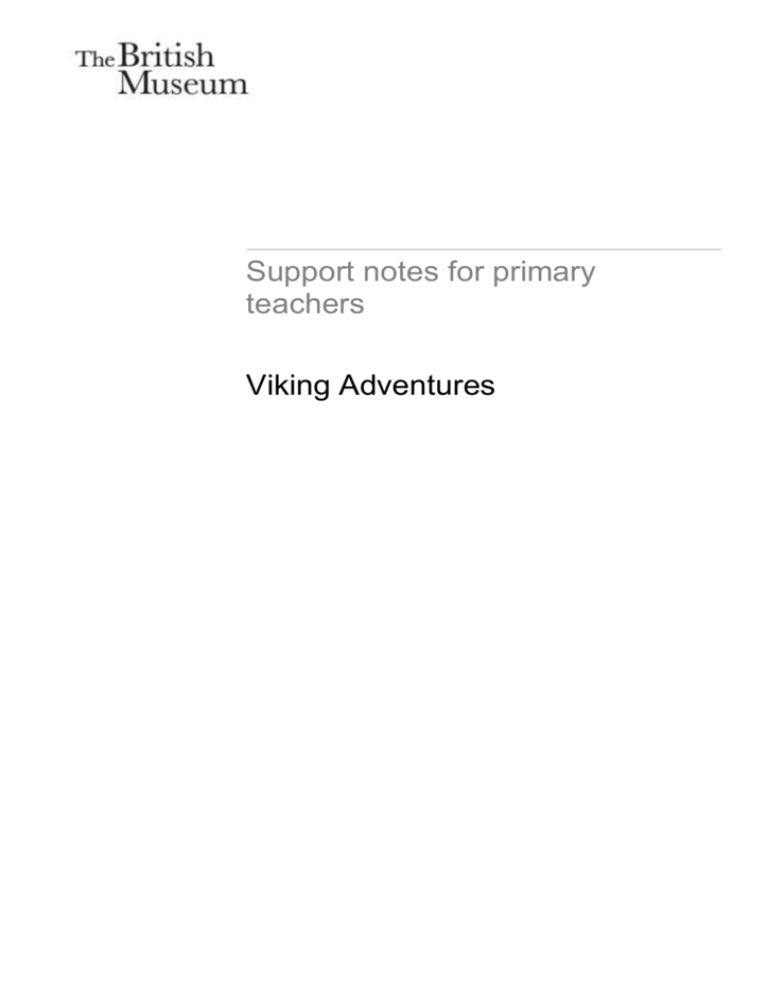
Support notes for primary teachers Viking Adventures About the film The film includes exclusive footage filmed in the special exhibition Vikings: life and legend and around the British Museum. It covers a broad variety of topics including: everyday life in the Viking Age Viking ships Viking food Viking warriors and warfare Old Norse, the language of the Vikings Viking beliefs archaeology The film lasts sixty minutes. The film carries a U certificate. Curriculum links The film offers opportunities in the following curriculum areas and for crosscurricular work: History Find out about archaeology and how evidence is found, types of evidence and the lives of women, men and children in the past. English The idea of sea voyages and the experience of the people involved offers great potential for a wide range of writing and oral work, including poetry and drama. Geography Learn about the Scandavanian homelands from which the Vikings travelled by water to trade, and sometimes settle, across four continents. Science Explore materials and their properties, organic and non-organic material and the effect of weathering. Art and design Viking jewellery and decorative objects offer a rich starting point for art and design activities. Design technology Discover how the Vikings used design and building skills to create the ships which enabled them to travel far from their Viking homelands. RE Learn about belief systems of the time. The Vikings themselves followed first pagan beliefs and later the Christain faith while their trading brought them into contact with the Jewish and Islam faiths. Dead bodies A section of the film will include refrences to human remains excavated by archaeologists. Response to ancient human remains can range from exaggerated revulsion to prurient interest to emotional upset. We recommend talking with students about human remains in school, before the film. Discuss how the discovery, excavation and study of human remains inform us about people in the past, how they lived and how human remains remind us that distant historical times involve real people. Support notes for primary teachers Viking Adventures 2 Preparation and follow-up Here are a few suggestions of things to do in the classroom before and after the film. Preparation Use maps to identify the locations of the Viking homelands. Look at Viking objects in the Explore section of britishmuseum.org The scholar Alcuin of York (c.735-804) wrote about the arrival of the first Vikings in Britain. Read and discuss some extracts from his work. What view of the Vikings is given by Alcuin? Why do you think that Alcuin of York thought about Vikings in this way? Is this how we think about Vikings nowadays? What do the students expect/hope to learn about the Vikings in the film? Create a bank of questions. Afterwards decide which questions were answered in the film and which ones will need further research at school. Read some extracts from the Laxdaela Saga – an epic story written around the year AD 1245. The saga recalls significant people and events as the unknown author looks back at the history of the people living in the Breiðafjörður area of Iceland from the late 9th century to the early 11th century. The most recent English translation is by Keneva Kunz, The Saga of the People of Laxardal and Bolli Bollason's Tale (Penguin Classics, 2008). The word ‘fawel’ (pronounced ‘fa-vel’) is used in modern Norwegian and Swedish to mean goodbye or farewell. The word may go back to Viking times. Research and try out some other Scandinavian words or phrases. Research the English language words for the days of the week and find out how some are based on Viking names. Tuesday, Wednesday, Thursday, Friday come from Tiw/Tyr, Woden/Odin, Thor and Frigg. Just to complete the week Saturday is from the Roman god Saturn, and Sunday and Monday represent the sun and the moon. Research the names of some other Norse gods and goddesses. Watch the ‘Building a Viking ship’ animation created for the Smithsonian Institution's National Museum of Natural History as part of their Vikings: The North Atlantic Saga exhibition. youtube.com/watch?v=78kpzwGmBxk&feature=related Support notes for primary teachers Viking Adventures 3 Follow-up Discuss the film with your students. What did they enjoy the most and why? What do they remember about it? Review the questions raised before watching the film. Which ones have been answered and which need further research? Ask your students to write a review of the film. Use published cinema film reviews to provide guidance and inspiration. Look at cinema film posters. Students could design their own poster for the Viking Adventures film. Write a travelogue from the point of view of a Viking travelling north, south, east or west. Or write a diary from the point of view of somebody waiting back in the Viking homelands. Find out about Norse kennings. Kennings are a way of naming something by creating a descriptive compound word in place of a single word noun; for example, in the Anglo-Saxon poem Beowulf the sea is called the ‘whale-road’, ‘sail-road’ and ‘swan-road’. Kennings can also be possessive phrases, for example, a ship might become the ‘rolling wagon of the ocean’ or the ‘wave’s rider’. A kenning can combine these two forms as in the kenning which refers to a ship as the ‘broad-hulled horse of the whale-land’. Make up some kennings. Look at images of Viking jewellery and craftwork. Create some Viking art with modern materials, for example modeling materials, foil, coloured modelling wire. In Norse mythology the god Odin made the world. First he created Jotunheim, the icy and cold land of the Giants, then Midgard, a warm world for humans with trees, lakes, rivers and plants and finally Asgard, a citadel of shining gold and silver palaces and towers. What might these three realms have looked like? Record ideas using art, music, descriptive writing, the spoken word or 3D modeling. Compare the Norse creation myth with those from other cultures. With your class revisit Alcuin of York’s thoughts on the Vikings. Did the film offer evidence with supported or challenged Alcuin’s description of the Vikings? How would the students describe the Vikings based on the objects shown in the film? Create a Viking trading catalogue. What items would be for sale? How many silver coins would each item cost? Research examples of Scandinavian loan words commonly used in the English language. For example, the word ‘bag’ comes from ‘baggin’ and ‘cake’ from ‘kaka’ while the words ‘egg’, ‘lad’, ‘race’, ‘same’ and’ troll’ are all Scandinavian loan words. Support notes for primary teachers Viking Adventures 4 Further resources A set of Viking objects from UK museums with associated information, images and teaching ideas can be found on the Teaching History with 100 Objects website at http://teachinghistory100.org/ The BBC website has a set of information sheets and associated images on the Vikings which could be helpful when doing your follow up at www.bbc.co.uk/history/ancient/vikings/ There is also information about archaeology at bbc.co.uk/history/ancient/archaeology/ The website of the National Museum of Denmark which holds many Viking objects can be found at natmus.dk/en/ Information on the Viking Age can be found at natmus.dk/en/historical-knowledge/denmark/prehistoric-period-until-1050ad/the-viking-age/ The website of the Viking Ship Museum, home of the Viking ship Roskilde 6 can be found at vikingeskibsmuseet.dk/en/ There is an animation showing how a Viking ship was built at youtube.com/watch?v=78kpzwGmBxk&feature=related Support notes for primary teachers Viking Adventures 5

